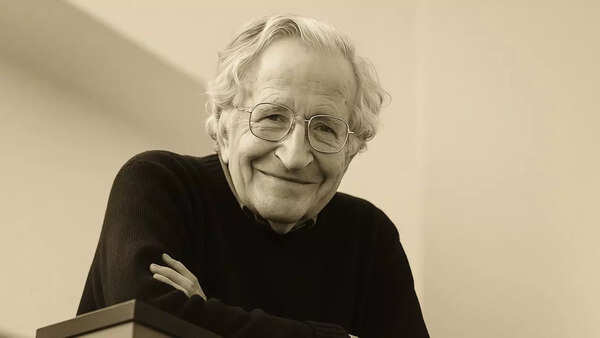Instant Scholar: Hum Chomsky’s PhD thesis ‘Transformational Analysis’ rebuilt linguistics

In 1955, the name of a young scholar Noam chomski A doctoral thesis is presented at the University of Pennsylvania which will bring revolution in the field Linguistics And do the ground work for what will become Fierce grammarTopic Transformative analysisChomsky’s thesis was a rigid, mathematical inspired criticism for Syntax and an ambitious offer for a new type of linguistic theory – which was inherent in formal rules and abstract mental structures.
This early task, although less known than its subsequent publications, marked the beginning of Chomsky’s challenge for the practical conservatives dominating linguistics and psychology in the middle of the 20th century. The first formally mentioned in transformational analysis will reach the widespread audience with the publication of 1957 Syntax structureA condensed and more accessible version of his thesis. Yet thesis itself remains a seminal document in intellectual history.
Also Read: Noam Chomsky for Beginers: What you should know about the world’s largest living intellectuals
Intellectual References: Behavioralism, Structuralism, and Linguistics Status
To fully appreciate the importance of transformational analysis, it is important to understand the intellectual climate in which Chomsky was working. The mid-century American linguistics dominated structural methods, especially influenced by the work of Leonard Bloomfield, and behavioral psychology. The language was mainly seen as a set of habits learned, devoid of environmental stimuli and congenital structures.
Linguistic analysis was empirical and descriptive – in the spoken language to catalog to Fonies, Morphems and Pattern. Syntax was considered as a surface phenomenon, which was less responsible for rigorous formality than vowel science. There was very little space in this structure for abstract mental structures or congenital knowledge.

Trained in both linguistics and mathematics, Chomski was dissatisfied with the descriptive boundaries of structuralism. He believed that linguistic principle should not only describe the surface pattern, but should highlight mental grammar – the set of internal rules – which allows speakers to produce and understand an infinite number of sentences, many of which they have never heard before.
Thesis observation: rules, structure and transformative revolution
Transformative analysis introduced several radical ideas that would eventually redefine linguistic theory. At its core, the assumption was that Syntax should not be understood as a flat, linear sequence but as a system of hierarchically structured representatives generated by formal rules. Chomsky proposed that the sentences are obtained from the underlying “deep structures” Transformational rules Map them on this observation “surface structures”.
Thesis developed a formal model of grammar, including:
- The phrase structure rule – these generate basic sentence structures or “kernel sentences” by re -combining noun phrases and verb phrases).
- Transforming rules – These are modified to produce kernel sentences to produce more complex surface forms, such as passive construction, question, or negative.
- Lexical Inclusion Rules – These insert real words in the appropriate syntax categories during the etymology process.
For example, the passive sentence “The book was read by the student” can be obtained from the kernel “The student reads the book the book” through a set of changes that re -organize the subject and the object and insert the supporting actions.
This model allowed Chomski to convince linguistic events such as ambiguity, contradiction, and sentences embedded in the way that structural models could not. Importantly, it offered a finite mechanism to generate an infinite number of grammatical sentences – a central concern in generative grammar.
Formal hardness and the effect of mathematics
A striking feature of transformational analysis is its formality. Chomski, logician Emil Post and mathematician Zelig Harris (his disserted manner), applied methods ranging from formal logic and automata theory to linguistics. He defined grammar as formal systems, which were able to produce linguistic wires and classified them that later Chomsky would become hierarchy – classification of formal grammar based on their general power.
This mathematics of language was unprecedented. While the previous linguists described the pattern, Chomski created a clear principle of Syntax, which was able to tested and be false. It was not only descriptive – it was explanatory.
Ease of seeds
Although transformational analysis focuses on the formal model, it also introduced basic ideas about the spontaneity of the language and “poverty of stimulation” – the perception that children receive complex grammar despite limited inputs. It challenged behavioral principles, instead suggested that humans are an officer of a congenital linguistic faculty.
Thesis helped to instigate cognitive revolution by bringing the mind – especially back to scientific focus to unconscious mental structures. While not widely known at the first time, its impact exploded after the Chomsky published Syntactic Straits (1957), which removed its major insight and launched the generative grammar movement.
Over time, Chomski refined his principles, eventually proposed a minimum program in the 1990s, but the main insights from transformational analysis – that syntax is generative, mental and formally structured – reconsideration founder. Even critics accept their role in re -shaping linguistics and affecting psychology, philosophy and artificial intelligence.
Transformative analysis was not just a thesis – it was the origin of a paradigm change. By rejecting behavioralism and formally to an internal approach of the language, Chomski formed the basis for modern cognitive science and how we study the human mind.
PDF of NOAM Chomski’s ‘transformational analysis’:
,Instantaneous scholar‘Is a time of individual to make educational research accessible to widespread audiences. If you Ph.D. Scholars and want to publish a summary of their research in this section, please share a summary and authority to publish it. Submission, and for any question on this initiative, write us on [email protected]




